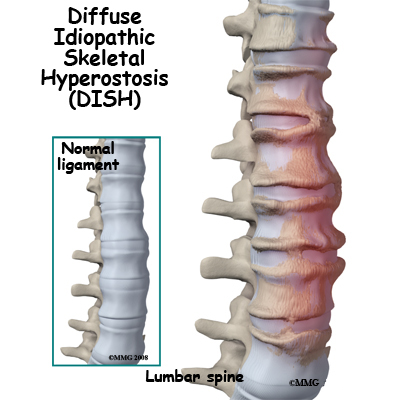Nursing Paper Example on Diffuse Idiopathic Skeletal Hyperostosis (DISH)
Nursing Paper Example on Diffuse Idiopathic Skeletal Hyperostosis (DISH)
(Nursing Paper Example on Diffuse Idiopathic Skeletal Hyperostosis (DISH)) Diffuse idiopathic skeletal hyperostosis (DISH), also known as Forestier disease, is a non-inflammatory systemic condition characterized by ossification of ligaments and entheses, primarily affecting the axial skeleton. Unlike inflammatory spondyloarthropathies, DISH does not involve sacroiliac joint inflammation or significant degenerative changes. The condition is often asymptomatic but can lead to pain, stiffness, or severe complications such as dysphagia or spinal cord compression. Early recognition and management are crucial for improving quality of life in affected individuals.

Causes of DISH
The precise cause of DISH remains unknown, but genetic, metabolic, and environmental factors are implicated.
Metabolic Factors
Obesity, type 2 diabetes mellitus, and hyperlipidemia are strongly associated with DISH.
Hyperinsulinemia may stimulate osteoblast activity, leading to abnormal bone formation.
Age and Sex
DISH predominantly affects individuals over 50 years of age.
Males are more frequently affected than females.
Genetic Predisposition
Familial clustering suggests a genetic component, although specific genes are yet to be identified.
Signs and Symptoms
DISH may remain asymptomatic or present with various clinical features depending on the affected sites.
Common Symptoms
Spinal stiffness: Particularly in the thoracic region, with limited flexibility.
Pain: Localized to areas of ligament ossification, often aggravated by activity.
Severe Symptoms
Dysphagia: Difficulty swallowing due to anterior cervical spine ossification.
Neurological deficits: Rarely, compression of spinal nerves or the spinal cord may occur.
Extraspinal Symptoms
Ossification in peripheral entheses, such as the Achilles tendon, can cause pain and functional limitations.
(Nursing Paper Example on Diffuse Idiopathic Skeletal Hyperostosis (DISH))
Etiology
The etiology of DISH involves the interaction of mechanical, metabolic, and genetic factors.
Mechanical Stress
Chronic mechanical stress may trigger bone remodeling and ossification.
Metabolic Dysregulation
Insulin-like growth factors and other metabolic pathways stimulate osteoproliferation in susceptible individuals.
Inflammatory Mediators
Although non-inflammatory by definition, low-grade inflammation might play a role in early stages.
Pathophysiology
The hallmark of DISH is extensive calcification and ossification of ligaments and entheses, primarily in the axial skeleton.
Spinal Changes
Ossification most commonly affects the anterior longitudinal ligament in the thoracic spine.
The ossified ligament creates flowing bony bridges, visible on radiographic imaging.
Extraspinal Involvement
Enthesopathy in peripheral joints may involve the pelvis, elbows, or heels.
Exclusion of Inflammatory Changes
Unlike ankylosing spondylitis, DISH spares the sacroiliac joints and does not cause systemic inflammation.
Diagnosis
Clinical Evaluation
Diagnosis begins with recognizing symptoms such as spinal stiffness and localized pain.
Radiological Criteria
Flowing ossifications along four or more contiguous vertebrae.
Preservation of intervertebral disc height without significant degenerative changes.
Absence of sacroiliac joint erosion or sclerosis.
Differential Diagnosis
Conditions like ankylosing spondylitis, osteoarthritis, and spondylosis must be ruled out.
Treatment Regimens
There is no cure for DISH, and treatment focuses on symptom management and preventing complications.
Conservative Management
Physical therapy: Improves spinal flexibility and reduces stiffness.
Pain management: Non-steroidal anti-inflammatory drugs (NSAIDs) and analgesics relieve symptoms.
Lifestyle Modifications
Weight loss and glycemic control are crucial for metabolic syndrome-related DISH.
Ergonomic interventions may help manage mechanical stress.
Surgical Intervention
Reserved for severe cases involving dysphagia or neurological compression.
Procedures include resection of ossified structures or spinal decompression.
Patient Education
Understanding DISH
Educate patients about the non-inflammatory nature of the condition.
Explain the slow progression and potential complications.
Activity and Exercise
Encourage regular stretching and low-impact exercises to maintain spinal mobility.
Avoid heavy lifting or activities that exacerbate mechanical stress.
Monitoring and Follow-Up
Regular follow-ups to monitor progression and manage metabolic comorbidities.
Imaging studies as needed for symptom evaluation or surgical planning.
Complications of DISH
Local Complications
Ossification of the anterior cervical spine may cause dysphagia or respiratory obstruction.
Enthesopathy in peripheral joints can lead to reduced mobility.
Neurological Complications
Rarely, ossified ligaments may compress the spinal cord or nerve roots, causing neurological deficits.
Systemic Risks
Associated with metabolic syndrome, increasing the risk of cardiovascular disease.
Prognosis
DISH is a chronic condition with a variable course. Many individuals remain asymptomatic, while others experience progressive stiffness and pain. Early diagnosis and appropriate management improve the quality of life and minimize complications.
Conclusion
Diffuse idiopathic skeletal hyperostosis is a unique musculoskeletal condition requiring a multidisciplinary approach for effective management. Early detection, symptom relief, and addressing metabolic comorbidities are essential in improving outcomes. Further research is needed to understand the disease’s genetic and molecular mechanisms to develop targeted therapies.
References
Forestier, J., & Rotes-Querol, J. (1950). Senile ankylosing hyperostosis of the spine. Annals of the Rheumatic Diseases, 9(4), 321-330. https://ard.bmj.com/content/9/4/321
Resnick, D., & Shaul, S. R. (1975). Diffuse idiopathic skeletal hyperostosis (DISH): Forestier’s disease with extraspinal manifestations. Radiology, 115(3), 513-524. https://pubs.rsna.org/doi/10.1148/115.3.513
UpToDate. (2023). Diffuse idiopathic skeletal hyperostosis. https://www.uptodate.com/contents/diffuse-idiopathic-skeletal-hyperostosis
Littlejohn, G. (2017). Diffuse idiopathic skeletal hyperostosis (DISH): Pathogenesis and clinical features. Nature Reviews Rheumatology, 13(12), 741-755. https://www.nature.com/articles/nrrheum.2017.185
Mader, R., et al. (2009). Diffuse idiopathic skeletal hyperostosis: A common but little-known condition. The Israel Medical Association Journal, 11(5), 299-306. https://www.ima.org.il/medicine/ViewPage.aspx?PageId=6


